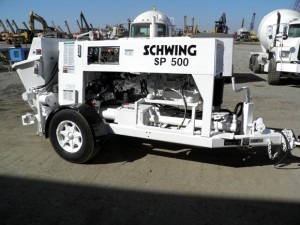How to Remove a Concrete Pumping Piston Cup
Concrete pumping is a critical activity at some point on most contractors’ job sites. So when your pump needs maintenance or repairs, you are being hit twice. Once for the expense for the service, and again for losing the use of the pump. Doing it yourself can give you a lot of satisfaction, and save money, but only if you know what you are doing. We refurbish many concrete pumps every week here, so I want to share our tips for removing the piston cup from your pump.
Positioning of the Rods
Turn the machine on. It doesn’t really matter whether you bring your piston side or your rod side up (piston side is the driver and rod side is the passenger). Let’s assume you bring your rod side all the way up.
- To begin removing the piston cup, use the quarter-turn valve to lock the shifting cylinders and pressure the machine up. Now the piston will come all the way into the water box.
- Next stop the pump. Turn the machine off by hitting one of the e-stops. This verifies that the accumulator is been dumped and the pistons can’t move which would damage the pump, or you! For extra safety, turn key off and remove the ground on the battery.
- MAKE SURE THE CHROME ROD IS ALL THE WAY BACK. Otherwise the piston will NOT come out.
Removing the Piston Rods
Now you are ready to begin removing the rods:
- Locate the concrete pump’s 2 bolts on the connecting rod and the other 2 on the dog bone connecting to the piston cup.
- Use a 65mm open-end wrench on the dog bone so you can spin it until you get 2 bolts visible on the top side.
- Leave the wrench on the dog bone so as you are loosening the 2 bolts, the cup won’t spin on you. The wrench will eventually spin, but don’t worry, it will only hit the sides of the water box.
- Remove these bolts and spin the whole assembly around to the other 2 bolts on the bottom. Repeat the process.
- Place a pry bar in the water box, apply pressure between the mud cup and the dog bone to push the mud cup a little ways into the material cylinder to allow the dog bone to fall down into the water box.
- Place your hand in the water box and pull the dog bone out.
- Use your pry bar again to remove the flange from the mud cup and start working it towards the water box until it falls down.
Get Back to Concrete Pumping – Cleanup and Installation
Now that you have the machine disassembled, clean the parts for re-installation so you can get your pump back on the construction site.
- Clean up the dog bone, the rod, the cup, the screws and the chromed bevel on the material cylinders. Material cylinders on a concrete pump don’t come straight to an end point, the have a bevel at the end. Make sure when cleaning and grinding the grout off this bevel, you can see the chrome when done.
- Grease the mud cup (the more the grease the better).
- Walk the NEW mud cup in there and then use the pry bar again to work the it into the start of the cylinder.
- Once it is partially in the cylinder, you need pressure to get it all the way in so turn your power up, turn the pump ON in low idle, and from the volume control, decrease the strokes so the pistons will go slow.
- Hit pump forward and since you are still locked, it’s only going to go one way. If you hit forward and it pressures out, that means you have to go in reverse for the pistons to go the other way.
- Hit reverse until it meets the mud cup. Check to make sure that it’s going to go in straight and start the OFF and ON with the switch until it pushes the mud cup into the material cylinder.
- Measure about how much the dog bone is going to make up the difference as you are pushing it in. So when you are re-installing it, it will fit right into the mud cup and the rod cup.
- Now you just doe the reverse of what you did to remove it. Start replacing the 2 bolts on the top using your wrench and spinning the dog bone. Spinning the mud cup will be hard since it’s new. Just use a pipe for leverage on your wrench when you do the 2 bolts on the bottom.
Conclusion
We hope these pump maintenance tips help you get back to pumping concrete quickly! If you are not comfortable with this procedure, we recommend using a professional for the safety of your equipment and yourself.
WARNING! We recommend getting the help of a professional. This posting is only to be used as a guideline for experienced professionals. Please refer to your operator manuals for more instructions and safety precautions. JED Alliance Group is not responsible for the misuse of this information.
Do you want to learn more about maintaining your equipment or concrete pumping? See our concrete pumps for sale in Florida that we export worldwide. We have many models of restored Schwing, Putzmeister, and Mayco pumps. Call us today at 321 251 4844 or drop by our Kissimmee, FL, facility.
What are your experiences with maintaining and repairing concrete pumps? Comment below!

